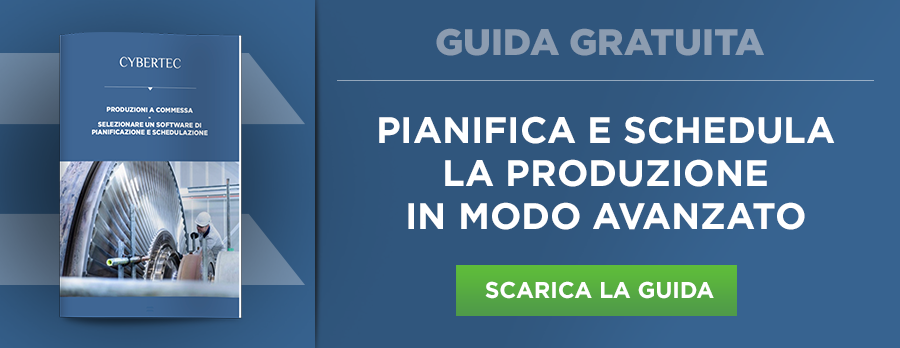Today many companies are innovating their processes and tools used to plan production, in order to improve the production flow and enjoy improvements across the board. To do this, they equip their Planning department with the production of digital tools, which replace the old, and now outdated, manual methods. But whatis production planning and what can be done in this area today?
Whatis production planning
Production process planning or production planning is a process carried out by manufacturing companies to determine future production activities. These activities are defined both in terms of what operations to carry out, and when and in what order to carry them out; this with reference to business processes, both in the medium and long term.
Why plan company production?
The purpose of production planning or scheduling is to optimize the use of company resources in order to maximize the level of service to customers both in terms of speed and compliance with delivery dates and flexibility, as well as to improve numerous company performance indices.
What are the inputs and outputs of production planning?
A production planning process starts from the analysis of product sales orders to customers to arrive at the best production plan, whose quality varies according to the criteria used and decided by the company itself.
To calculate the plan, the process processes a series of information, such as warehouse data (batches, stocks, deadlines, etc.), bill of materials (also known as BOM or Bill Of Materials), existing constraints in the production plant (both machinery and personnel) as well as tooling times and other variables, depending on the instrument used. It is therefore important to have previously carried out an excellent mapping of business processes.
Who is involved in production planning
Production planning is also a complex process for the number and type of figures that directly or indirectly involve different departments and functions. The roles most directly involved in this process are:
- The Programming Manager, or the one who is actually in charge of analyzing the orders and planning the production plan by coordinating the production activity;
- The Production Manager collaborates with the previous one in the creation of the plan and interfaces with purchases and sales to ensure the maintenance and improvement of production performance;
- The Supply Chain Manager has visibility of the schedule to ensure that the plan is feasible and supervises the processes of the entire supply chain to ensure that they are aligned from raw material purchases to final logistics;
- Purchasing Department, has vision of the plan, especially of the first phases, to know when the materials must be available, to the production department;
- Sales Department, has vision of the plan, especially of the last phases, to have visibility of the scheduled, promised and effective delivery dates in order to communicate effectively with customers.
Each company has its own peculiarities and the same also applies to the internal organisation, as a result the roles and tasks mentioned above may vary in some realities. In addition to this, it should be noted that other roles may also have visibility and a say in production planning. Property, Management and Information Services, for example, are all linked by interests of a different nature to this business process.

The Disadvantages of Manual Scheduling
Manual planning is the starting point of every production planning process in a manufacturing company. This type of planning is in fact found in small companies, which have a relatively simple planning to manage, where the products are not very complex or where the unforeseen events do not happen. It is easy to understand that these scenarios are extremely rare today. Planning of this type has several disadvantages, such as:
- Inability to manage unforeseen events;
- Great difficulty in managing the missing ones;
- Little or no vision of future production scenarios;
- Difficult communication and collaboration;
- Isolation of information in “silos”;
- Slow and cumbersome re-planning.
In short, such planning is becoming increasingly anachronistic and difficult to manage. When it begins to represent an obstacle, rather than a support for the production department, it is time to evaluate solutions to support the production planning and scheduling department.
The benefits of digital planning
Digital planning, on the other hand, uses software solutions such as Advanced Planning and Scheduling or APS to manage a modern, collaborative, up-to-date and timely production schedule. In addition, the most advanced solutions also use finite capacity logic, to allow planners to take into account the physical limits of their production department.
The benefits of the department that a manufacturing company has thanks to the use of planning are of different types and benefit different departments, from operations to sales, from management to planning. Some of these benefits are:
- Reduction of low-value assets
- Elimination of the so-called “missing”
- Saturation of production resources
- Reduction of production lead times
- Reduction of “downtime”
- What-if simulations in real time
- Preventive identification of critical issues
- Service Level Improvement
- Reduction of inventory levels
- Increase in inventory turnover
Production planning tools
Companies that plan production the “old-fashioned way” (manually or analogically) use tools that have big limits, this is even more evident if you compare these systems to the digital tools used by leading companies. Tools such as spreadsheets and projects in fact block communication in files isolated from each other, their sharing is difficult and does not allow a series of in-depth analyses that allow to make predictions, reason at finite capacity and see the KPIs in a graphically effective way. The software for production planning, in fact, allows you to:
- Simulate different future production scenarios (what-if analysis);
- Create feasible production plans considering factory constraints (finished capacity);
- Interact between different users to adjust the initially proposed plan;
- Maximize visibility into the planning of the entire supply chain, from demand forecasting to the purchasing plan and work sequences.
CyberPlan and production planning
You can download the free guide that will allow you to learn more about the benefits of using Advanced Planning and Scheduling software. Learn how to plan and schedule production in an advanced and digital way, click here.

